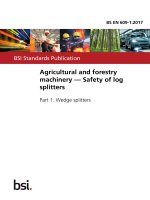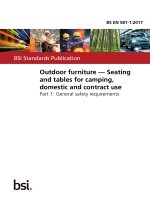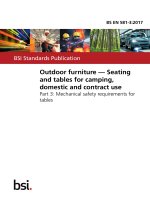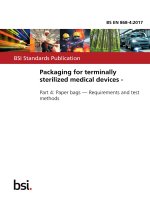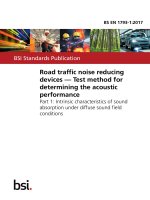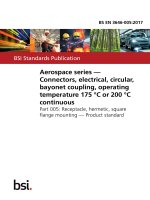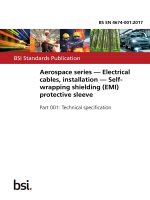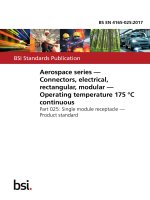Bsi bs en 61643 351 2017
Bạn đang xem bản rút gọn của tài liệu. Xem và tải ngay bản đầy đủ của tài liệu tại đây (2.59 MB, 32 trang )
BS EN 61643-351:2017
BSI Standards Publication
Components for low-voltage
surge protective devices
Part 351: Performance requirements and test
methods for telecommunications and signalling
network surge isolation transformers (SIT)
BRITISH STANDARD
BS EN 61643-351:2017
National foreword
This British Standard is the UK implementation of EN 61643-351:2017. It is
identical to IEC 61643-351:2016.
The UK participation in its preparation was entrusted by Technical
Committee PEL/37, Surge Arresters - High Voltage, to Subcommittee
PEL/37/1, Surge Arresters - Low Voltage.
A list of organizations represented on this committee can be obtained on
request to its secretary.
This publication does not purport to include all the necessary provisions of
a contract. Users are responsible for its correct application.
© The British Standards Institution 2017.
Published by BSI Standards Limited 2017
ISBN 978 0 580 85903 8
ICS 33.040.99
Compliance with a British Standard cannot confer immunity from
legal obligations.
This British Standard was published under the authority of the
Standards Policy and Strategy Committee on 28 February 2017.
Amendments/corrigenda issued since publication
Date
Text affected
BS EN 61643-351:2017
EUROPEAN STANDARD
EN 61643-351
NORME EUROPÉENNE
EUROPÄISCHE NORM
February 2017
ICS 33.040.99
English Version
Components for low-voltage surge protective devices Part 351: Performance requirements and test methods for
telecommunications and signalling network surge isolation
transformers (SIT)
(IEC 61643-351:2016)
Composants pour parafoudres basse tension Partie 351: Exigences de performance et méthodes d'essai
pour les transformateurs d'isolement contre les surtensions
dans les réseaux de signalisation et de télécommunications
(IEC 61643-351:2016)
Bauelemente für Überspannungsschutzgeräte für
Niederspannung - Teil 351: Leistungsanforderungen sowie
Prüfschaltungen und -verfahren für
Blitzisoliertransformatoren in Telekommunikations- und
signalverarbeitenden Netzen
(IEC 61643-351:2016)
This European Standard was approved by CENELEC on 2016-12-02. CENELEC members are bound to comply with the CEN/CENELEC
Internal Regulations which stipulate the conditions for giving this European Standard the status of a national standard without any alteration.
Up-to-date lists and bibliographical references concerning such national standards may be obtained on application to the CEN-CENELEC
Management Centre or to any CENELEC member.
This European Standard exists in three official versions (English, French, German). A version in any other language made by translation
under the responsibility of a CENELEC member into its own language and notified to the CEN-CENELEC Management Centre has the
same status as the official versions.
CENELEC members are the national electrotechnical committees of Austria, Belgium, Bulgaria, Croatia, Cyprus, the Czech Republic,
Denmark, Estonia, Finland, Former Yugoslav Republic of Macedonia, France, Germany, Greece, Hungary, Iceland, Ireland, Italy, Latvia,
Lithuania, Luxembourg, Malta, the Netherlands, Norway, Poland, Portugal, Romania, Serbia, Slovakia, Slovenia, Spain, Sweden,
Switzerland, Turkey and the United Kingdom.
European Committee for Electrotechnical Standardization
Comité Européen de Normalisation Electrotechnique
Europäisches Komitee für Elektrotechnische Normung
CEN-CENELEC Management Centre: Avenue Marnix 17, B-1000 Brussels
© 2017 CENELEC All rights of exploitation in any form and by any means reserved worldwide for CENELEC Members.
Ref. No. EN 61643-351:2017 E
BS EN 61643-351:2017
EN 61643-351:2017
European foreword
The text of document 37B/155/FDIS, future edition 1 of IEC 61643-351, prepared by SC 37B “Specific
components for surge arresters and surge protective devices” of IEC/TC 37 “Surge arresters" was
submitted to the IEC-CENELEC parallel vote and approved by CENELEC as EN 61643-351:2017.
The following dates are fixed:
•
latest date by which the document has to be
implemented at national level by
publication of an identical national
standard or by endorsement
(dop)
2017-09-02
•
latest date by which the national
standards conflicting with the
document have to be withdrawn
(dow)
2019-12-02
Attention is drawn to the possibility that some of the elements of this document may be the subject of
patent rights. CENELEC [and/or CEN] shall not be held responsible for identifying any or all such
patent rights.
Endorsement notice
The text of the International Standard IEC 61643-351:2016 was approved by CENELEC as a
European Standard without any modification.
In the official version, for Bibliography, the following notes have to be added for the standards indicated:
2
IEC 60060-1:2010
NOTE
Harmonized as EN 60060-1:2010 (not modified).
IEC 60068-2-1:2007
NOTE
Harmonized as EN 60068-2-1:2007 (not modified).
IEC 60068-2-2:2007
NOTE
Harmonized as EN 60068-2-2:2007 (not modified).
IEC 60076-1
NOTE
Harmonized as EN 60076-1.
IEC 60721-3-9:1993
NOTE
Harmonized as EN 60721-3-9:1993 (not modified).
IEC 61340-4-8
NOTE
Harmonized as EN 61340-4-8.
IEC 61558-1
NOTE
Harmonized as EN 61558-1.
IEC 61558-2-4
NOTE
Harmonized as EN 61558-2-4.
IEC 61558-2-6
NOTE
Harmonized as EN 61558-2-6.
BS EN 61643-351:2017
EN 61643-351:2017
Annex ZA
(normative)
Normative references to international publications
with their corresponding European publications
The following documents, in whole or in part, are normatively referenced in this document and are
indispensable for its application. For dated references, only the edition cited applies. For undated
references, the latest edition of the referenced document (including any amendments) applies.
NOTE 1 When an International Publication has been modified by common modifications, indicated by (mod), the relevant
EN/HD applies.
NOTE 2 Up-to-date information on the latest versions of the European Standards listed in this annex is available here:
www.cenelec.eu
Publication
Year
Title
IEC 60721-3-3
-
Classification of environmental conditions - EN 60721-3-3
- Part 3: Classification of groups of
environmental parameters and their
severities Section 3: Stationary use at
weatherprotected locations
-
Insulation coordination for equipment
within low-voltage systems Part 2-1: Application guide - Explanation of
the application of the IEC 60664 series,
dimensioning examples and dielectric
testing
-
IEC/TR 60664-2-1 2011
EN/HD
Year
3
–2–
BS EN 61643-351:2017
IEC 61643-351:2016 © IEC 2016
CONTENTS
FOREWORD ........................................................................................................................... 4
INTRODUCTION ..................................................................................................................... 6
1
Scope .............................................................................................................................. 7
2
Normative references ...................................................................................................... 7
3
Terms, definitions, symbols, abbreviations and acronyms ................................................ 7
3.1
Terms and definitions .............................................................................................. 7
3.2
Symbols ................................................................................................................ 10
3.3
Abbreviations and acronyms ................................................................................. 12
4
Service conditions ......................................................................................................... 12
4.1
Temperature range ............................................................................................... 12
4.2
Humidity ............................................................................................................... 12
4.3
Altitude ................................................................................................................. 12
4.4
Microclimate ......................................................................................................... 12
5
SIT surge conditions ...................................................................................................... 13
5.1
SIT surge mitigation .............................................................................................. 13
5.2
Common-mode surges .......................................................................................... 14
5.3
Differential-mode surges ....................................................................................... 14
6
Characteristics .............................................................................................................. 15
6.1
Characteristic measurement ................................................................................. 15
6.2
Input winding to output winding capacitance ......................................................... 15
6.3
Insulation resistance (IR) ...................................................................................... 16
6.4
Signal SIT voltage-time product ............................................................................ 18
7
Ratings .......................................................................................................................... 19
7.1
Rated impulse withstand voltage ........................................................................... 19
7.2
Signal SIT rated winding direct current .................................................................. 22
8
Identification .................................................................................................................. 24
8.1
8.2
8.3
Annex A
General ................................................................................................................. 24
Datasheet ............................................................................................................. 24
Marking ................................................................................................................. 24
(informative) 1,2/50 impulse .................................................................................. 25
Bibliography .......................................................................................................................... 26
Figure 1 – Symbol for two-winding SIT .................................................................................. 10
Figure 2 – Symbol for a two-winding SIT with polarity indication ........................................... 11
Figure 3 – Symbol for a two-winding SIT with electric screen ................................................ 11
Figure 4 – SIT with centre tapped windings ........................................................................... 11
Figure 5 – Common-mode surge conditions for SIT ............................................................... 13
Figure 6 – Common-mode surge conditions for SIT with an electric screen ........................... 14
Figure 7 – Test circuit to measure SIT internal-winding capacitance ..................................... 15
Figure 8 – Test circuit to measure the internal-winding capacitance of SIT with an
electric screen ...................................................................................................................... 16
Figure 9 – Test circuit to measure the insulation resistance of SIT ........................................ 17
Figure 10 – Test circuit to measure the insulation resistance of SIT with an electric
screen .................................................................................................................................. 17
Figure 11 – Test circuit to measure SIT voltage-time product ................................................ 18
BS EN 61643-351:2017
IEC 61643-351:2016 © IEC 2016
–3–
Figure 12 – Generator and SIT secondary voltage waveforms ............................................... 18
Figure 13 – SIT rated impulse voltage test circuit .................................................................. 19
Figure 14 – Rated impulse voltage test circuit for SIT with an electric screen ........................ 20
Figure 15 – Construction of pass/fail template from the 1,2/50 open-circuit waveform ........... 20
Figure 16 – Pass/fail template and test waveforms ............................................................... 21
Figure 17 – Winding conductor temperature rise test circuit .................................................. 23
Figure A.1 – 1,2/50 time periods and voltage amplitudes ...................................................... 25
Table 1 – Classification of microclimate condition ................................................................. 12
Table 2 – Impulse withstand test voltage for rated impulse voltage ....................................... 22
Table A.1 – 1,2/50 voltage impulse generator parameters ..................................................... 25
BS EN 61643-351:2017
IEC 61643-351:2016 © IEC 2016
–4–
INTERNATIONAL ELECTROTECHNICAL COMMISSION
____________
COMPONENTS FOR LOW-VOLTAGE SURGE PROTECTIVE DEVICES –
Part 351: Performance requirements and test methods
for telecommunications and signalling network surge
isolation transformers (SIT)
FOREWORD
1) The International Electrotechnical Commission (IEC) is a worldwide organization for standardization comprising
all national electrotechnical committees (IEC National Committees). The object of IEC is to promote
international co-operation on all questions concerning standardization in the electrical and electronic fields. To
this end and in addition to other activities, IEC publishes International Standards, Technical Specifications,
Technical Reports, Publicly Available Specifications (PAS) and Guides (hereafter referred to as “IEC
Publication(s)”). Their preparation is entrusted to technical committees; any IEC National Committee interested
in the subject dealt with may participate in this preparatory work. International, governmental and nongovernmental organizations liaising with the IEC also participate in this preparation. IEC collaborates closely
with the International Organization for Standardization (ISO) in accordance with conditions determined by
agreement between the two organizations.
2) The formal decisions or agreements of IEC on technical matters express, as nearly as possible, an international
consensus of opinion on the relevant subjects since each technical committee has representation from all
interested IEC National Committees.
3) IEC Publications have the form of recommendations for international use and are accepted by IEC National
Committees in that sense. While all reasonable efforts are made to ensure that the technical content of IEC
Publications is accurate, IEC cannot be held responsible for the way in which they are used or for any
misinterpretation by any end user.
4) In order to promote international uniformity, IEC National Committees undertake to apply IEC Publications
transparently to the maximum extent possible in their national and regional publications. Any divergence
between any IEC Publication and the corresponding national or regional publication shall be clearly indicated in
the latter.
5) IEC itself does not provide any attestation of conformity. Independent certification bodies provide conformity
assessment services and, in some areas, access to IEC marks of conformity. IEC is not responsible for any
services carried out by independent certification bodies.
6) All users should ensure that they have the latest edition of this publication.
7) No liability shall attach to IEC or its directors, employees, servants or agents including individual experts and
members of its technical committees and IEC National Committees for any personal injury, property damage or
other damage of any nature whatsoever, whether direct or indirect, or for costs (including legal fees) and
expenses arising out of the publication, use of, or reliance upon, this IEC Publication or any other IEC
Publications.
8) Attention is drawn to the Normative references cited in this publication. Use of the referenced publications is
indispensable for the correct application of this publication.
9) Attention is drawn to the possibility that some of the elements of this IEC Publication may be the subject of
patent rights. IEC shall not be held responsible for identifying any or all such patent rights.
International Standard IEC 61643-351 has been prepared by subcommittee 37B: Specific
components for surge arresters and surge protective devices, of IEC technical committee 37:
Surge arresters.
The text of this standard is based on the following documents:
FDIS
Report on voting
37B/155/FDIS
37B/156/RVD
Full information on the voting for the approval of this International Standard can be found in
the report on voting indicated in the above table.
This document has been drafted in accordance with the ISO/IEC Directives, Part 2.
BS EN 61643-351:2017
IEC 61643-351:2016 © IEC 2016
–5–
A list of all parts in the IEC 61643 series, published under the general title Components for
low-voltage surge protective devices, can be found on the IEC website.
Future standards in this series will carry the new general title as cited above. Titles of existing
standards in this series will be updated at the time of the next edition.
The committee has decided that the contents of this document will remain unchanged until the
stability date indicated on the IEC website under "" in the data related to
the specific document. At this date, the document will be
•
reconfirmed,
•
withdrawn,
•
replaced by a revised edition, or
•
amended.
–6–
BS EN 61643-351:2017
IEC 61643-351:2016 © IEC 2016
INTRODUCTION
This part of IEC 61643 covers surge isolation transformers whose rated impulse withstand
voltage coordinates with the expected surge environment of the installation. This type of
surge protective component, SPC, isolates and attenuates transient voltages in conjunction
with current diverting components (e.g. GDT, MOV, etc.) or surge protective devices (SPDs).
It can be used in SPDs.
BS EN 61643-351:2017
IEC 61643-351:2016 © IEC 2016
–7–
COMPONENTS FOR LOW-VOLTAGE SURGE PROTECTION –
Part 351: Performance requirements and test methods
for telecommunications and signalling network surge
isolation transformers (SIT)
1
Scope
Surge isolation transformers (SITs) are used for signal transformer applications with signal
levels up to 400 V peak to peak. SITs are transformers, with or without an internal-winding
screen, with a rated impulse withstand voltage greater than the peak voltage of the expected
common-mode surge environment. SITs are applicable to components for surge protection
against indirect and direct effects of lightning or other transient overvoltage. SITs are used to
mitigate the onward propagation of common-mode voltage surges. This part of IEC 61643
defines test circuits and test methods for determining and verifying the SIT surge parameters.
Preferred performance values for key parameters are given.
This part of IEC 61643 does not cover SIT operation under differential-mode lightning surge
conditions.
2
Normative references
The following documents are referred to in the text in such a way that some or all of their
content constitutes requirements of this document. For dated references, only the edition
cited applies. For undated references, the latest edition of the referenced document (including
any amendments) applies.
IEC 60721-3-3, Classification of environmental conditions – Part 3: Classification of groups of
environmental parameters and their severities – Section 3: Stationary use at weatherprotected
locations
IEC TR 60664-2-1:2011, Insulation coordination for equipment within low-voltage systems –
Part 2-1: Application guide – Explanation of the application of the IEC 60664 series,
dimensioning examples and dielectric testing
3
3.1
Terms, definitions, symbols, abbreviations and acronyms
Terms and definitions
For the purposes of this document, the following terms and definitions apply.
ISO and IEC maintain terminological databases for use in standardization at the following
addresses:
•
IEC Electropedia: available at />
•
ISO Online browsing platform: available at />
3.1.1
surge isolation transformer
SIT
isolation transformer which has high impulse withstand voltage with/without electric screen
between input and output windings
–8–
BS EN 61643-351:2017
IEC 61643-351:2016 © IEC 2016
3.1.2
electric screen
ES
screen of conductive material intended to reduce the penetration of an electric field into a
given region
[SOURCE: IEC 60050-151:2001, 151-13-10]
3.1.3
breakdown
failure, at least temporarily, of the insulating properties of an insulating medium under electric
stress
[SOURCE: IEC TR 61340-1:2012, 3.4]
3.1.4
component type
manufacturer’s type of a component, e.g. its product name
3.1.5
clearance
shortest distance in air between two conductive parts
[SOURCE: IEC TR 60664-2-1:2011, 3.4]
3.1.6
creepage distance
shortest distance along the surface of a solid insulating material between two conductive
parts
[SOURCE: IEC TR 60664-2-1:2011, 3.7]
3.1.7
guarded measurement
measurement technique in a three terminal network that allows the direct impedance between
two terminals to be measured correctly by applying a compensating voltage to the third
terminal that removes the shunting effects of any impedances to the third terminal
3.1.8
insulation resistance
resistance under specified conditions between two conductive elements separated by
insulating materials
[SOURCE: IEC TS 61994-4-2:2011, 3.10]
3.1.9
impulse withstand voltage
highest peak value of impulse voltage of prescribed form and polarity which does not cause
breakdown of insulation under specified conditions
[SOURCE: IEC TR 60664-2-1:2011, 3.15]
3.1.10
isolating transformer
transformer with protective separation between the input and output windings
[SOURCE: IEC 60065:2014, 2.7.1]
BS EN 61643-351:2017
IEC 61643-351:2016 © IEC 2016
–9–
3.1.11
insulation
that part of an electrotechnical product which separates the conducting parts at different
electrical potentials
[SOURCE: IEC TR 60664-2-1:2011, 3.17]
3.1.12
insulation coordination
mutual correlation of insulation characteristics of electrical equipment taking into account the
expected micro-environment and other influencing stresses
[SOURCE: IEC TR 60664-2-1:2011, 3.18]
3.1.13
overvoltage
any voltage having a peak value exceeding the corresponding peak value of maximum
steady-state voltage at normal operating conditions
[SOURCE: IEC TR 60664-2-1:2011, 3.21]
3.1.14
lightning overvoltage
transient overvoltage at any point of the system due to a specific lightning discharge
[SOURCE: IEC 60664-1:2007, 3.7.4]
3.1.15
thermal equilibrium
variation of less than 1 K between any two out of three consecutive measurements made at
an interval of 5 min
[SOURCE: IEC 61810-1:2014, 3.3.13]
3.1.16
thermal resistance
quotient of the temperature difference between two specified points or regions and the heat
flow between these two points or regions under conditions of thermal equilibrium
Note 1 to entry:
For most cases, the heat flow can be assumed to be equal to the power dissipation.
[SOURCE: IEC 62590:2010, 3.9.1]
3.1.17
microclimate
climatic condition at the place where a component is installed in the product
Note 1 to entry: Only the inside product maximum air temperature (classes X1 to X7) and, optionally, the
maximum air humidity class (classes Y1 to Y4) are taken into account.
[SOURCE: IEC 60721-3-9:1993, 3.1, modified – addition of Note 1 to entry]
BS EN 61643-351:2017
IEC 61643-351:2016 © IEC 2016
– 10 –
3.1.18
virtual front time
T1
<of a voltage impulse> 1/0,6 times the interval T between the instants when the impulse is
30 % and 90 % of the peak value
SEE: Figure A.1
[SOURCE: IEC 60060-1:2010, 7.1.18, modified]
3.1.19
virtual origin
O1
<of the impulse voltage waveform> instant at which a straight line drawn through the 30 %
and 90 % amplitude values crosses the time axis
SEE: Figure A.1
[SOURCE: IEC 60060-1:2010, 7.1.19, modified]
3.1.20
virtual time to half-value
T2
interval of time between the instant of virtual origin O 1 and the instant when the voltage or
current has decreased to half the peak value
SEE: Figure A.1
3.1.21
designation of an impulse shape
combination of two numbers, the first representing the virtual front time (T 1 ) and the second
the virtual time to half-value on the tail (T 2 )
Note 1 to entry:
It is written as T 1 /T 2 , both in microseconds, the sign "/" having no mathematical meaning.
[SOURCE: IEC 60099-4:2014, 3.13]
3.2
Symbols
For the purposes of this document, the following symbols apply.
Figure 1 shows the symbol for a two-winding SIT.
P1
S1
P2
S2
IEC
Key
P1: Primary winding terminal 1
S1: Secondary winding terminal 1
P2: Primary winding terminal 2
S2: Secondary winding terminal 2
Figure 1 – Symbol for two-winding SIT
BS EN 61643-351:2017
IEC 61643-351:2016 © IEC 2016
– 11 –
Figure 2 shows the symbol for a two-winding SIT with instantaneous voltage polarity
indicators, similar to the S00843 symbol of IEC 60617 made with terminal connections.
P1
S1
P2
S2
IEC
Key
P1: Primary winding terminal 1
S1: Secondary winding terminal 1
P2: Primary winding terminal 2
S2: Secondary winding terminal 2
Figure 2 – Symbol for a two-winding SIT with polarity indication
Figure 3 shows the symbol for a two-winding SIT with an electric screen between the windings,
similar to the S00853 symbol of IEC 60617 made with terminal connections.
P1
S1
P2
S2
E
IEC
Key
P1: Primary winding terminal 1
S1: Secondary winding terminal 1
P2: Primary winding terminal 2
S2: Secondary winding terminal 2
E : Earth terminal (electric screen terminal)
Figure 3 – Symbol for a two-winding SIT with electric screen
Figure 4 shows the symbol for a SIT centre tapped windings, similar to the S00855 symbol of
IEC 60617 made with two centre tapped windings and terminal connections. When testing is
done with shorted windings the centre tap is also connected to the short, other testing is done
without any connection to the centre tap terminal.
P1
S1
CT
CT
P2
S2
IEC
Key
P1: Primary winding terminal 1
S1: Secondary winding terminal 1
P2: Primary winding terminal 2
S2: Secondary winding terminal 2
CT: Centre tap terminal
Figure 4 – SIT with centre tapped windings
BS EN 61643-351:2017
IEC 61643-351:2016 © IEC 2016
– 12 –
3.3
Abbreviations and acronyms
For the purposes of this document, the following abbreviations and acronyms apply.
ES
electric screen
ICT
information and communications technology
IR
insulation resistance
rms
root-mean-square
SIT
surge isolation transformer
SPD
surge protective device
4
Service conditions
4.1
Temperature range
Normal range: −20 °C to 40 °C
Extended range: This range is decided based on agreement between manufacturer and user.
4.2
Humidity
Not exceeding 90 %.
4.3
Altitude
Normal range: Not exceeding 1 000 m.
Extended range: This range is decided based on agreement between manufacturer and user.
4.4
Microclimate
When microclimate conditions apply, use one of the classes given in Table 1.
Table 1 – Classification of microclimate condition
High air temperature
severity
Class
Product application
°C
°C
a
Typical component
temperature range
55
X1
70
X2
0 to 70
Commercial
85
X3
−40 to 85
Industrial
100
X4
125
X5
−55 to 125
Military
155
X6
−65 to 150
Storage a
200
X7
Storage temperature rating verification is outside the scope of this document. See IEC 60068-2-1:2007 and
IEC 60068-2-2:2007.
BS EN 61643-351:2017
IEC 61643-351:2016 © IEC 2016
5
– 13 –
SIT surge conditions
5.1
SIT surge mitigation
An SIT couples a service across the transformer insulation by magnetic induction. When
common-mode surges occur on the incoming service the insulation is voltage-stressed. The
insulation has three physical paths:
a) solid insulation – insulation material interposed between the two-windings;
b) creepage distance;
c) clearance.
Clearance distances shall be set so that the maximum expected voltage difference does not
break down the clearance. Creepage distances shall be set so that the maximum expected
voltage difference and pollution degree do not cause surface flashover or breakdown
(tracking). Solid insulation thickness shall be set so that the maximum expected voltage
difference does not cause breakdown.
The higher frequency components of a surge impulse will be electrostatic coupled by SIT
internal-winding capacitance (shown as C P-SA + C P-SB ) from one winding to the other (see
Figure 5).
C P-SA
ZS
WP
WS
ZT
R
C P-SB
IEC
Key
C P-SA , C P-SB : Primary to secondary capacitance, paths A and B
W P:
Primary winding
W S:
Secondary winding
ZT:
Terminating or load impedance
ZS:
Service source impedance
R:
Reference plane or point
Figure 5 – Common-mode surge conditions for SIT
To reduce internal-winding capacitance, a conducting electric screen can be used between
the windings (see Figure 6). The electric screen decouples most of the winding capacitance
(shown as C P-Screen A , C P-Screen B , C S-Screen A and C S-Screen B ), leaving a much smaller value
of internal-winding capacitance (shown as C P-SA + C P-SB ).
BS EN 61643-351:2017
IEC 61643-351:2016 © IEC 2016
– 14 –
C P-SA
C P-Screen
C S-Screen
A
ZS
WS
WP
A
ZT
ES
C P-Screen
C S-Screen
B
B
R
C P-SB
IEC
Key
W P:
Primary winding
C P-Screen
A,
C P-Screen B : Primary to screen capacitance, paths A and B
W S:
Secondary winding
C S-Screen A , C S-Screen B : Secondary to screen capacitance, paths A and B
ES:
Electric screen
C P-SA , C P-SB :
ZS:
Service source
impedance
R:
Reference plane or point
Primary to secondary unscreened capacitance, paths A and B
Z T : Terminating or load impedance
Figure 6 – Common-mode surge conditions for SIT with an electric screen
5.2
Common-mode surges
Figure 6 shows SIT under common-mode surge conditions. The insulation rated impulse
voltage shall be equal to or greater than the peak common-mode surge voltage for insulation
coordination (see 7.1). Any primary to secondary capacitance (shown as C P-SA + C P-SB ) that
is not decoupled by the electric screen (ES) provides a capacitive current flow path from the
primary to secondary circuit (see 6.2).
The major parameters for common-mode surges are the rated impulse voltage and the
internal-winding capacitance, plus a post-test insulation resistance check on the insulation
integrity.
5.3
Differential-mode surges
Differential-mode surges are typically caused by system asymmetry converting what should
be common-mode surges to differential ones. SIT action occurs on differential-mode surges
and the SIT does little to mitigate them. In some cases SIT bandwidth will result in filtering of
the output surge frequency spectrum.
Signal SITs may suffer core saturation, which truncates the secondary voltage. Some
standards specify testing for differential power faults, requiring the signal SIT to have a
primary winding current rating.
BS EN 61643-351:2017
IEC 61643-351:2016 © IEC 2016
6
– 15 –
Characteristics
6.1
Characteristic measurement
Characteristics are measureable component parameters at the time of test and the values
obtained are for the component tested. Characteristics may be specified by the manufacturer
as typical, maximum, minimum or combinations of these quantities.
The temperature and humidity environment for the characteristic measurements shall be
IEC 60721-3-3, class 3K1:
a) low temperature 20 °C ± 2 °C;
b) high temperature 25 °C ± 2 °C;
c) low relative humidity 20 %;
d) high relative humidity 75 %.
6.2
Input winding to output winding capacitance
This test measures the effective internal-winding capacitance of SIT.
a) Test method
Figure 7 shows a test circuit to measure SIT internal-winding capacitance. In Figure 7,
only SIT capacitive component is shown. Both the primary winding W P and secondary
winding W S are short-circuited. The internal-winding capacitance is measured between the
two shorts.
WP
WS
C P-S
F
IEC
Key
W P : Primary winding
C P-S :
Primary to secondary capacitance
W S : Secondary winding
F:
Capacitance meter
Figure 7 – Test circuit to measure SIT internal-winding capacitance
Figure 8 shows a test circuit to measure the internal-winding capacitance of SIT with an
electric screen, ES. In Figure 8, only SIT capacitive components are shown. Both the
primary winding W P and secondary winding W S are short-circuited. The internal-winding
capacitance is measured between the two shorts. A guarded measurement of the internalwinding capacitance shall be made to remove the winding to electric screen capacitances.
Guarded measurements are done using either three-wire (Hi, Lo, Guard) or six-wire (Hi,
Lo, Guard feed and Hi, Lo, Guard sense) techniques. Figure 8 shows the use of a
Blumlein three-wire transformer ratio arm bridge. The use of coaxial cables removes the
connecting cable shunting capacitance from the measurement.
BS EN 61643-351:2017
IEC 61643-351:2016 © IEC 2016
– 16 –
WP
WS
C P-S
G
G
C S-Screen
C P-Screen
ES
CL
CH
G
G
F
IEC
Key
W P : Primary winding
C P-Screen : Primary to Screen capacitance
W S : Secondary winding
C S-Screen : Secondary to Screen capacitance
ES: Electric screen
C P-S : Primary to Secondary residual capacitance
C H : Capacitance measurement connection Hi
G: Guard connection (coaxial cables screen)
C L : Capacitance measurement connection Lo
F: Guarded measurement capacitance bridge
Figure 8 – Test circuit to measure the internal-winding
capacitance of SIT with an electric screen
By connecting the guard G to the primary and the measurement leads to the two
remaining connections, the secondary to electric screen capacitance C S-Screen may be
measured. Similarly, connecting the guard G to the secondary and the measurement leads
to the two remaining connections, the primary to electric screen capacitance C P-Screen
may be measured.
b) Values
This document covers AC low frequency power, high frequency switching of any size and
construction. With this degree of variation, it is impractical to create a list of preferred
values. The internal-winding capacitance value can be used to predict the level of
capacitive surge current passed on to the following circuitry.
c) Criteria
The measured value of internal-winding capacitance shall be within the manufacturer’s
specified limits. When the manufacturer only gives a typical value, if the measured value is
outside ±30 % the typical value, the manufacturer should be contacted to verify the
measurement technique and product parameter distribution.
6.3
Insulation resistance (IR)
This test measures the resistance of the insulation at a defined DC voltage.
a) Test method
The insulation resistance meter shall be set for the specified value of DC test voltage, see
6.3 b). The test voltage shall be applied for at least 60 s before the insulation resistance
value is taken. Figure 9 shows the test circuit to measure the insulation resistance of SIT.
Both the primary winding W P and secondary winding W S are short-circuited. The insulation
resistance is measured between the two shorts.
BS EN 61643-351:2017
IEC 61643-351:2016 © IEC 2016
– 17 –
WS
WP
Ω
IEC
Key
W P : Primary winding
Ω: IR meter with defined DC bias
W S : Secondary winding
Figure 9 – Test circuit to measure the insulation resistance of SIT
Figure 10 shows the test circuit to measure the insulation resistance of SIT with an electric
screen. Both the primary winding W P and secondary winding W S are short-circuited. The
insulation resistance is measured between the two shorts. Unless otherwise specified, two
measurements are taken: once with the selector switch SW connecting the electric screen
ES to the primary winding W P , and once with the selector switch SW connecting the
electric screen ES to the secondary winding W S .
WP
ES
WS
SW
Ω
IEC
Key
W P : Primary winding
Ω: IR meter with defined DC bias
W S : Secondary winding
SW: Two-position selector switch
ES: Electric screen
Figure 10 – Test circuit to measure the insulation
resistance of SIT with an electric screen
b) Value
The preferred test value of DC voltage is 500 V and the resistance reading is made after
the DC voltage has been applied for 60 s minimum.
c) Criteria
The insulation resistance values shall be 2 MΩ or more, measured at 500 V DC.
BS EN 61643-351:2017
IEC 61643-351:2016 © IEC 2016
– 18 –
6.4
Signal SIT voltage-time product
This test measures SIT voltage-time product, a measure of the secondary winding differentialmode surge let-through.
a) Test method
Figure 11 shows the test circuit for voltage-time measurement. The pulse generator, G has
adjustable voltage amplitude and pulse duration.
WP
WS
G
VS
O
IEC
Key
W P : Primary winding
G: Pulse generator, 50 Ω source impedance
W S : Secondary winding
O: Oscilloscope monitoring V S
V S : Instantaneous secondary winding voltage
Figure 11 – Test circuit to measure SIT voltage-time product
VS
VG
Figure 12 shows the generator open-circuit output voltage and the resultant secondary
winding voltage. The generator pulse voltage amplitude V G and duration are adjusted to
cause SIT core saturation. Core saturation is shown by the secondary winding voltage
pulse being truncated, having a shorter duration t S than the generator pulse. To allow
accurate measurement, the generator voltage amplitude shall be adjusted such that the
core saturation time t S is not less than 10 μs.
tS
0,5V S
IEC
Key
V G : Open-circuit pulse generator peak voltage
t S : Secondary winding voltage time above 50 % V S
V S : Instantaneous secondary winding peak voltage
Figure 12 – Generator and SIT secondary voltage waveforms
On the instantaneous secondary winding voltage V S , measure the peak amplitude V S and
the 50 % V S duration time t S . SIT voltage-time product is given by V S × t S expressed in
μV·s.
b) Value
SIT voltage-time product depends on SIT size, construction and the information and
communications technology (ICT) system. With this degree of variation, it is impractical to
create a list of preferred values. As an example, Ethernet SITs typically have a voltagetime product in the 50 μV·s region. The voltage-time product value can be used to predict
the peak secondary voltage level before truncation resulting from a defined surge
waveform when there are no secondary voltages limiting components.
c) Criteria
The measured value of voltage-time product shall be within the manufacturer’s specified
limits. When the manufacturer only gives a typical value, if the measured value is outside
BS EN 61643-351:2017
IEC 61643-351:2016 © IEC 2016
– 19 –
±30 % the typical value, the manufacturer should be contacted to verify the measurement
technique and product parameter distribution.
7
Ratings
7.1
Rated impulse withstand voltage
This test verifies the insulation rated impulse voltage specified by SIT manufacturer for the
component type.
a) Test method
The insulation rated impulse voltage is traditionally tested using a 1,2/50 voltage impulse,
see Annex A. This document only specifies insulation impulse testing as it is a universal
approach that can be used for component, device and equipment port testing. Figure 13
shows the test circuit used for insulation voltage withstand testing of SIT. A 1,2/50 impulse
generator, whose voltage waveform is monitored by oscilloscope O, has its impulse
voltage applied to the insulation separating windings W P and W S . Both the primary
winding W P and secondary winding W S are short circuited.
WS
WP
O
G
1,2/50
IEC
Key
W P : Primary winding
G: 1,2/50 surge generator
W S : Secondary winding
O: Oscilloscope or equivalent monitoring impulse voltage
Figure 13 – SIT rated impulse voltage test circuit
Figure 14 shows the test circuit used for insulation voltage withstand testing of SIT with an
electric screen. A 1,2/50 impulse generator, whose voltage waveform is monitored by
oscilloscope O, has its impulse voltage applied to the insulation separating windings W P
and W S . Both the primary winding W P and secondary winding W S are short circuited.
Unless otherwise specified, two measurements are taken: once with the selector switch,
SW connecting the electric screen ES to the primary winding W P , , and once with the
selector switch SW connecting the electric screen ES to the secondary winding W S .
BS EN 61643-351:2017
IEC 61643-351:2016 © IEC 2016
– 20 –
WP
WS
ES
SW
O
G
1,2/50
IEC
Key
W P : Primary winding
G: 1,2/50 surge generator
W S : Secondary winding
O: Oscilloscope or equivalent monitoring impulse voltage
ES: Electric screen
SW: Two-position selector switch
Figure 14 – Rated impulse voltage test circuit for SIT with an electric screen
d d
Before testing the insulation, a test pass/fail template shall be determined. First set the
generator G voltage to the impulse withstand voltage listed in Table 2 that corresponds to
SIT rated impulse voltage. Record the generator G voltage waveform. Construct a
template from the generator G open-circuit 1,2/50 waveform consisting of an upper limit,
created by moving the waveform up by 10 % of the peak amplitude, and a lower limit,
created by moving the waveform down by 10 % of the peak amplitude (see Figure 15).
IEC
Key
d:
Positive and negative vertical waveform displacement distance of the 1,2/50 open-circuit voltage waveform
Distance d is equal to 10 % of the peak open-circuit voltage.
Figure 15 – Construction of pass/fail template from the 1,2/50 open-circuit waveform
An example use of the template is shown in Figure 16, in which the template is shown as a
shaded area. To pass the insulation test, any waveform aberrations during the insulation
test shall not be outside the template area (see Figure 16 a)). Any insulation breakdown
causing aberrations such as waveform serration (Figure 16 b)) and truncation
(Figure 16 c)) are outside the template area and are test failures.
BS EN 61643-351:2017
IEC 61643-351:2016 © IEC 2016
IEC
a) Pass, test waveform within the
template constructed from the
1,2/50 open circuit voltage
waveform
– 21 –
IEC
b) Test failure, serrated test
waveform outside the
template area
IEC
c) Test failure, truncated test
waveform outside the
template area
Figure 16 – Pass/fail template and test waveforms
Using the test circuits of Figure 13 or Figure 14, as appropriate, apply the impulse
withstand test voltage corresponding to SIT insulation rated impulse voltage to the
insulation from the impulse generator G, while recording the impulse waveform on
oscilloscope O. Check if the recorded voltage complies with Figure 16 a). For SIT with an
electric screen, see Figure 14, repeat the test with the selector switch SW set in the
alternative position and check if the recorded voltage complies with Figure 16 a). After the
impulse withstand test, measure the insulation resistance as described in 6.3.
b) Value
Table 2 lists the preferred values for SIT insulation rated impulse voltage together with the
corresponding impulse withstand test voltage. To ensure the insulation rated impulse
voltage is at least its specified value the applied impulse withstand test voltage shall be
higher in voltage. The ratio of impulse withstand to rated impulse voltage used in Table 2
is 1,17 for voltages less than 4 kV and 1,23 for voltages of 4 kV and above in accordance
with IEC 60664-1 and IEC TR 60664-2-1:2011.
The test setup measures the combined withstand of creepage, clearance and insulation
barrier with the component mounted as specified.
